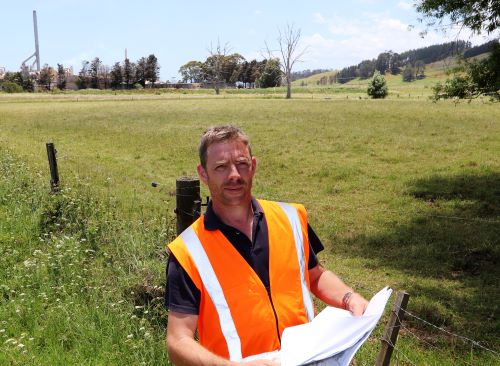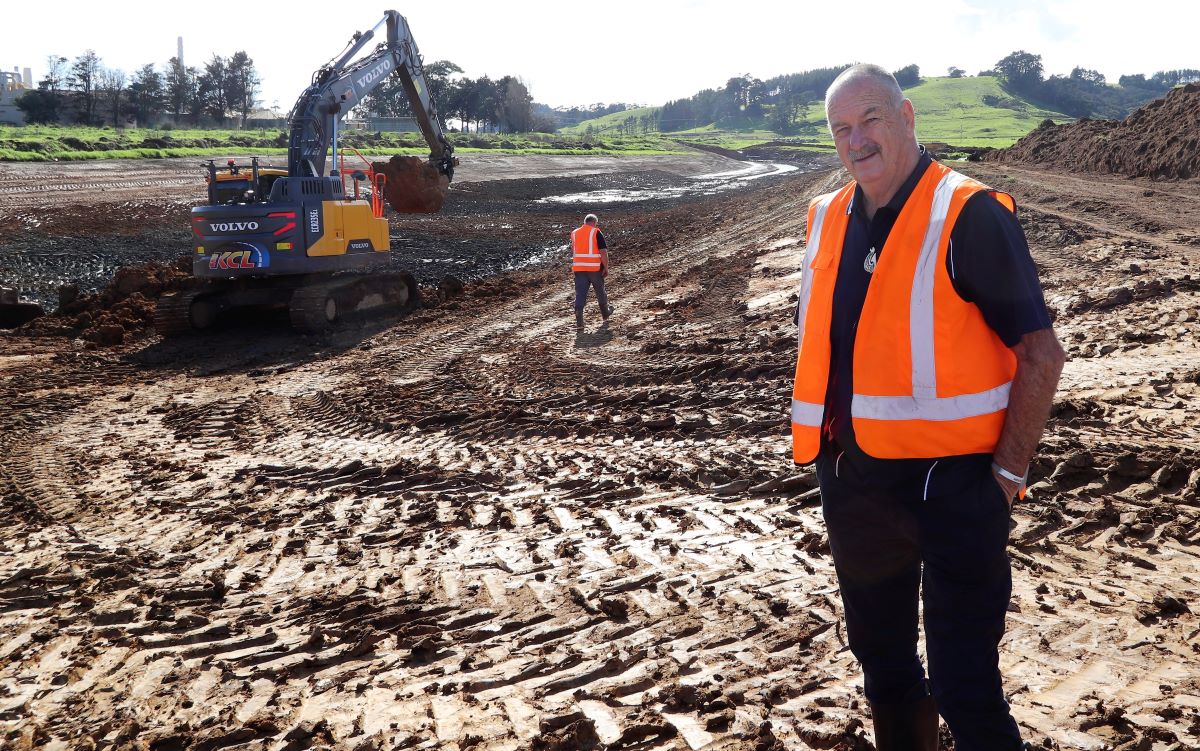Far North paddock turned into vital new spillway
25 Jun 2020, 7:30 AM
Hundreds of thousands of dollars’ worth of critical improvements to the Awanui flood scheme have just been completed despite several weeks of unscheduled delays caused by the nation’s pandemic response.
The Northland Regional Council says an estimated 90,000 tonnes of soil were removed to transform a Far North paddock into a vital new 400-metre long flood spillway behind Juken New Zealand’s Kaitaia triboard mill.
The works form part of the second stage of the council’s ongoing multimillion-dollar upgrade of the Awanui flood scheme and were completed recently.
The council’s Te Hiku constituency representative Councillor Colin ‘Toss’ Kitchen says it was hoped the work would have been finished by May, however, the national pandemic lockdown had thrown a spanner in the works, forcing a halt to construction for several weeks.
 BEFORE: Regional council River Management Engineer Barney Brotherhood in December last year with a Kaitaia paddock now transformed into a vital new piece of the Awanui flood scheme.
BEFORE: Regional council River Management Engineer Barney Brotherhood in December last year with a Kaitaia paddock now transformed into a vital new piece of the Awanui flood scheme.
Ironically, when work had resumed, a drier-than-normal winter had allowed efforts to continue beyond the usual end of the construction season and effectively claw back much of the lost time.
Councillor Kitchen says forestry and wood processing company JNL had allowed its land to be used for the crucial upgrade which will give better flood protection to the surrounding area including JNL’s Whangatane Dr triboard mill (one of the area’s largest employers).
“An adjoining private landowner was also a great assistance, allowing their property to be used during the earthworks and local tangata whenua also provided valuable input into the programme.”
He says the existing aging spillway – which will be retired within the next 12 months or so for a new life as a wetland – sits literally just a stone’s throw from the triboard mill. The new roughly 20-metre wide, 400-metre long spillway has been built approximately 100m to the south-east on what had been a paddock.
Roughly 90,000 tonnes of soil (about 50,000 cubic metres) had been removed during the paddock’s transformation.
The completed spillway will be given a few months to stabilise and for grass cover to establish before it is commissioned in Autumn next year and water from the river is diverted into it. The existing 400m of current spillway behind the triboard mill will then be retired for a new life as a wetland.
Councillor Kitchen says while the new works are about two kilometres downstream of Kaitaia itself, they’ll form an integral part of the upgraded scheme, helping to carry potentially damaging floodwaters away from the town more efficiently and quickly.
“The scale and cost of the Awanui upgrade overall means work began in earnest last year but will need to continue in stages over several construction seasons through until 2027.”
The recent spillway work accounted for most of the roughly $1 million spent upgrading the aging scheme this year. Much of the scheme was built about a century ago, and until fairly recently the NRC’s attention had of necessity been on much-needed maintenance and more immediate repairs.
“However, the upgrade programme will help future-proof the scheme for a number of years – including predicted effects from climate change – as well as deliver a considerably higher level of protection for Kaitaia and surrounding areas.”
Councillor Kitchen says scheme-wide, future flood risks will be mitigated largely through extensive modifications and improvements to stabilise existing stopbanks, which will allow the Awanui River – including critical sections upstream of the triboard mill – to carry up to 15 percent more floodwaters.
Designed to protect urban Kaitaia in a ‘once in a century’ type flood and a 1:20 year event in surrounding rural areas, the work is one of several key projects at the heart of the regional council’s NRC’s Long Term Plan (LTP) 2018-2028.
The council has said previously that without the added protection the upgrade will offer, a large flood in urban Kaitaia could cause tens of millions of dollars in damage and potentially put lives at risk.
Seventy percent of the work is being funded by ratepayers Northland-wide via a regional flood infrastructure rate, with the balance funded locally through a targeted Awanui River Management Rate.

AFTER: Regional councillor Colin (Toss) Kitchen checking progress in mid-June on the 400-metre stretch of new spillway that has taken shape behind Juken New Zealand’s Kaitaia triboard mill.
